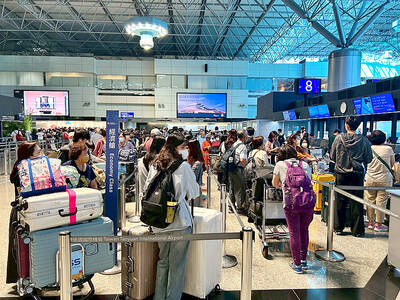The Taiwan Heart Foundation warned yesterday that consuming too much red yeast rice — a popular additive in local diets or supplements that is believed to reduce cholesterol levels naturally — could be harmful to the health.
The foundation urged those who eat red yeast rice to keep their daily intake to under 15g to prevent harmful side-effects to the liver and kidneys.
Red yeast rice is rice that has been fermented by the red yeast called Monascus purpureus. Fermented rice is used as a food preservative, food coloring and an ingredient in rice wine.
Huang Juei-jen (黃瑞仁), deputy executive director of the foundation, said that red yeast rice and foods made with it are usually used as a natural alternative to lovastatin — a prescription drug used to lower high blood lipids and cholesterol and reduce cardiovascular risk.
Excessive doses of lovastatin are harmful to the liver and kidneys, as well as skeletal muscle, Huang said, adding that consuming too much red yeast rice can have the same side effects because it is similar in terms of composition and effect to the drug.
People taking lovastatin who eat excessive amounts of red yeast rice to improve their medical conditions put themselves at even greater risk of liver and kidney disease, Huang said.
He called on those already taking lovastatin to consult their doctors before using red yeast rice as an alternative or supplement.
Hsieh Yen-yau (謝炎堯), deputy superintendent of the Koo Foundation Sun Yat-sen Cancer Center, said that when red yeast rice ferments, it can produce a fungus called Penicillium citrinum, which is toxic to the liver and kidneys.
Unknown sources of red yeast used for fermentation and sloppy manufacturing procedures can cause the growth of the fungus, said Hsieh, who urged the public to carefully choose products with quality certification.

Three batches of banana sauce imported from the Philippines were intercepted at the border after they were found to contain the banned industrial dye Orange G, the Food and Drug Administration (FDA) said yesterday. From today through Sept. 2 next year, all seasoning sauces from the Philippines are to be subject to the FDA’s strictest border inspection, meaning 100 percent testing for illegal dyes before entry is allowed, it said in a statement. Orange G is an industrial coloring agent that is not permitted for food use in Taiwan or internationally, said Cheng Wei-chih (鄭維智), head of the FDA’s Northern Center for

The Chinese military has built landing bridge ships designed to expand its amphibious options for a potential assault on Taiwan, but their combat effectiveness is limited due to their high vulnerability, a defense expert said in an analysis published on Monday. Shen Ming-shih (沈明室), a research fellow at the Institute for National Defense and Security Research, said that the deployment of such vessels as part of the Chinese People’s Liberation Army (PLA) Navy’s East Sea Fleet signals a strong focus on Taiwan. However, the ships are highly vulnerable to precision strikes, which means they could be destroyed before they achieve their intended

LOOKING NORTH: The base would enhance the military’s awareness of activities in the Bashi Channel, which China Coast Guard ships have been frequenting, an expert said The Philippine Navy on Thursday last week inaugurated a forward operating base in the country’s northern most province of Batanes, which at 185km from Taiwan would be strategically important in a military conflict in the Taiwan Strait. The Philippine Daily Inquirer quoted Northern Luzon Command Commander Lieutenant General Fernyl Buca as saying that the base in Mahatao would bolster the country’s northern defenses and response capabilities. The base is also a response to the “irregular presence this month of armed” of China Coast Guard vessels frequenting the Bashi Channel in the Luzon Strait just south of Taiwan, the paper reported, citing a

About 4.2 million tourist arrivals were recorded in the first half of this year, a 10 percent increase from the same period last year, the Tourism Administration said yesterday. The growth continues to be consistent, with the fourth quarter of this year expected to be the peak in Taiwan, the agency said, adding that it plans to promote Taiwan overseas via partnerships and major events. From January to June, 9.14 million international departures were recorded from Taiwan, an 11 percent increase from the same period last year, with 3.3 million headed for Japan, 1.52 million for China and 832,962 to South Korea,